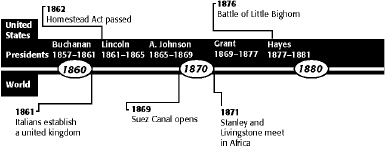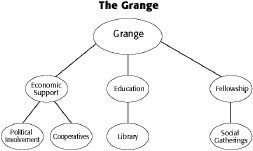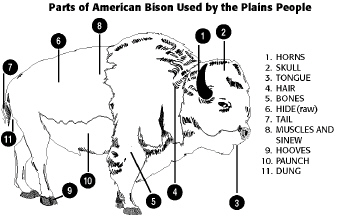Multiple Choice
Identify the
choice that best completes the statement or answers the question.
|
|
|
|
|
|
1.
|
 According to the graph, in what year was the
population of Virginia City at its peak?
|
|
|
2.
|
 According to the graph, what was the approximate
population of Virginia City in 1885? a. | 3,000 | c. | 10,000 | b. | 20,000 | d. | 12,000 |
|
|
|
3.
|
More than 200 Lakota Sioux were killed at
a. | Sand Creek. | c. | Little Bighorn. | b. | Wounded Knee. | d. | San Carlos. |
|
|
|
4.
|
Name one of the largest deposits of silver-bearing ore:
a. | Comstock Lode | c. | Sutter’s Mill | b. | Kennecott Mine | d. | Homestake Mine |
|
|
|
5.
|
  Based on the time line, which U.S.
event occurred during President Lincoln’s administration? a. | Italians establish a united kingdom | c. | Suez Canal
opens | b. | Homestead Act passed | d. | Stanley and Livingstone meet in Africa |
|
|
|
|
|
|
6.
|
 Study the map. Which railroad company began to lay
tracks westward starting in Omaha, Nebraska? a. | the Southern Pacific | c. | the Central Pacific | b. | the Northern Pacific | d. | the Union
Pacific |
|
|
|
7.
|
 In what territory were the two railroads joined with a
golden spike to complete the transcontinental railway? a. | Utah | c. | Colorado | b. | Idaho | d. | Wyoming |
|
|
|
8.
|
 In what town did the Central Pacific railroad begin
working eastward? a. | Omaha | c. | Sacramento | b. | Promontory Summit | d. | Virginia City |
|
|
|
9.
|
What law gave up to 160 free acres of land to a settler?
a. | Free Silver Act | c. | Dawes Act | b. | Free Land Act | d. | Homestead Act |
|
|
|
10.
|
What railroad connected the Atlantic and Pacific coasts?
a. | Northern railroad | c. | transcontinental railroad | b. | Atlantic
railroad | d. | Pacific
railroad |
|
|
|
|
|
|
11.
|
 The information on this map suggests that the action
at Wounded Knee was essentially which of the following? a. | massacre of whites | c. | a fair fight | b. | massacre of Native
Americans | d. | all of the
above |
|
|
|
12.
|
 In which of the following states did the Sioux people
live in the time period shown on the map? a. | Washington, Oregon, Idaho | b. | North Dakota, South Dakota,
Montana | c. | North Dakota, South Dakota, Minnesota | d. | Montana, Wyoming,
Colorado |
|
|
|
13.
|
One of the dangers on the cattle drives was
a. | loneliness. | c. | hard work. | b. | stampedes. | d. | discrimination. |
|
|
|
14.
|
A symbol that marks ownership burned into the hide of cattle is called
a. | a brand. | c. | a homestead. | b. | dry farming. | d. | a sodbuster. |
|
|
|
15.
|
The winner of the 1896 presidential election was
a. | James B. Weaver. | c. | William McKinley. | b. | Grover Cleveland. | d. | William Jennings
Bryan. |
|
|
|
16.
|
United States soldiers killed more than 200 Lakota Sioux at
a. | Sand Creek. | c. | San Carlos. | b. | Wounded Knee. | d. | Ghost Dance. |
|
|
|
17.
|
What dance celebrated the hoped-for day when white settlers would disappear and
the buffalo would return?
a. | Ghost Dance | c. | Sioux's Dance | b. | Wovoka's Dance | d. | Warrior's
Dance |
|
|
|
18.
|
  Based on the diagram, which of the
following was a goal of the Grange? a. | ecology | c. | sharecropping | b. | athletics | d. | education |
|
|
|
19.
|
  Based on the diagram, which parts of
the bison used by Native Americans came exclusively from its head? a. | skull, tongue, horns | c. | tail, sinew, skull | b. | hide, bones, hooves | d. | horns, tongue,
hooves |
|
|
|
20.
|
In boomtowns, people who dealt out their own brand of justice without benefit of
judge or jury were called
a. | busts. | c. | subsidies. | b. | vigilantes. | d. | miners. |
|
|
|
21.
|
Who was the leader of the Lakota Sioux who refused to sell the Black Hills of
the Dakotas?
a. | Black Kettle | c. | Chief Joseph | b. | Sitting Bull | d. | Crazy Horse |
|
|
|
22.
|
What is it called when thousands of cattle run in panic?
a. | homesteading | c. | dry farming | b. | a stampede | d. | a branding |
|
|
|
23.
|
The last Native American to surrender formally to the United States was
a. | Chief Joseph. | c. | Geronimo. | b. | Crazy Horse. | d. | Sitting Bull. |
|
|
|
24.
|
What political party was also known as the People’s Party?
a. | Democrat | c. | Populist | b. | Republican | d. | Libertarian |
|
|
|
25.
|
For most of their history, the needs of the Plains Native Americans were
supplied by
a. | horses. | c. | farming. | b. | fishing. | d. | the buffalo. |
|